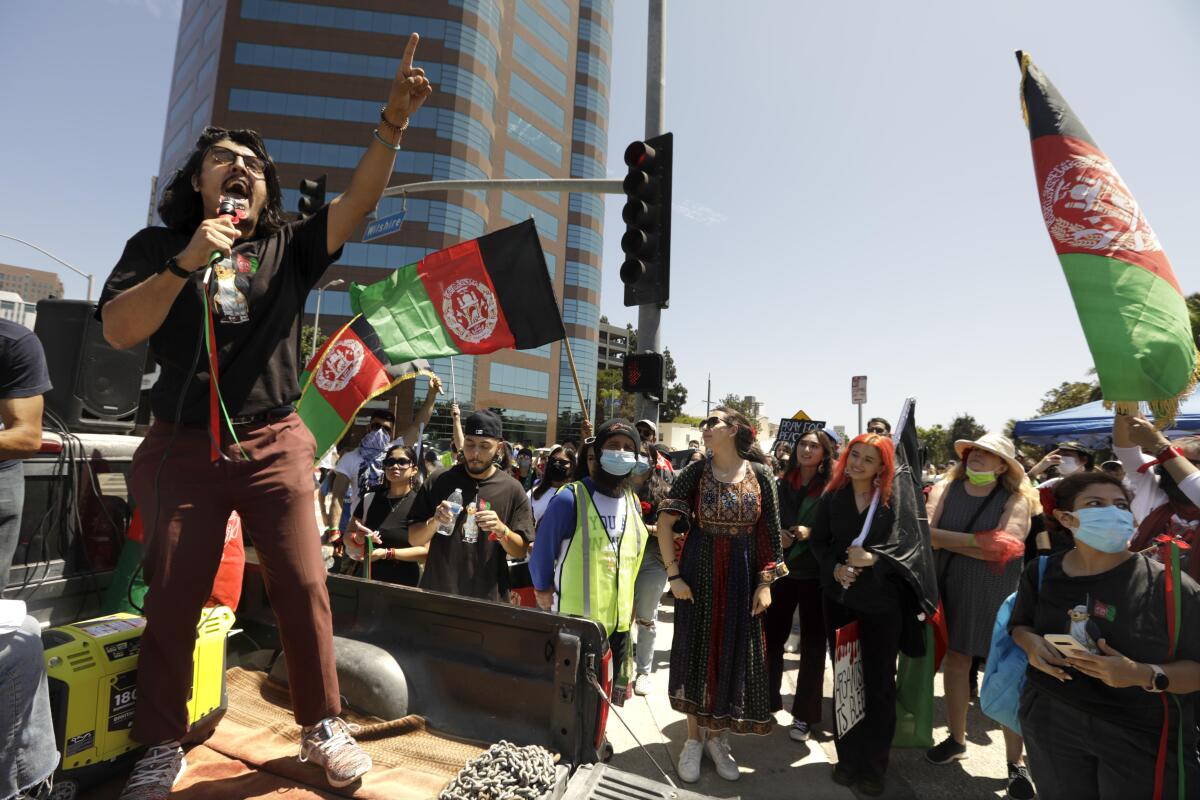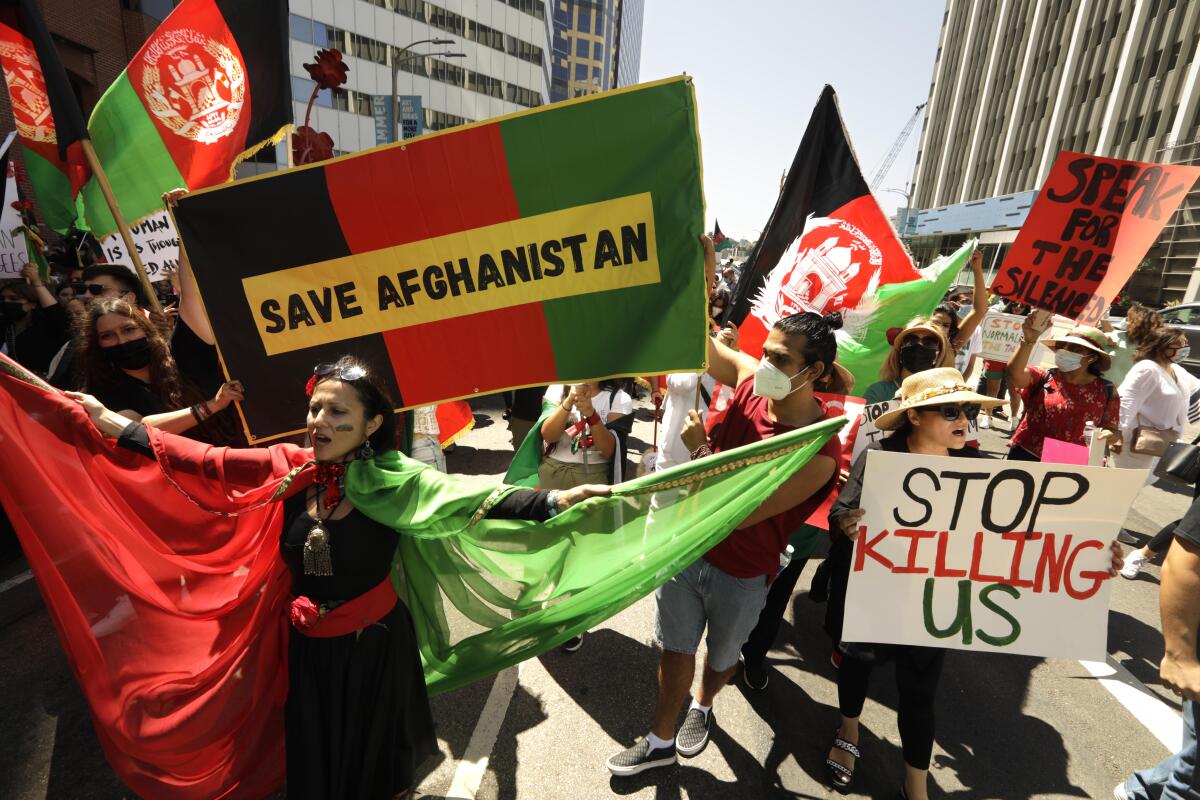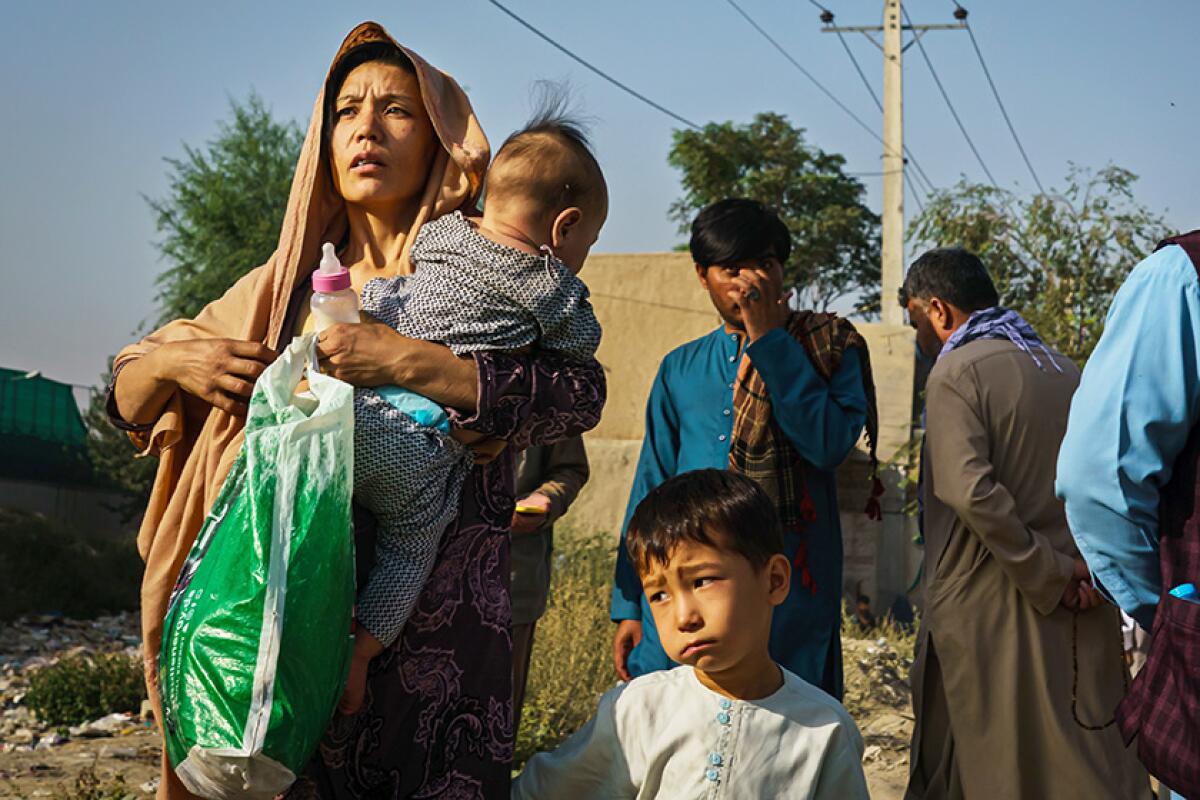The internet aided a digital Dunkirk. But under Taliban rule, Afghan activists go dark

- Share via
Earlier this month, Arash Azizzada, a 33-year-old Afghan American activist, slumped in a chair at his home in South L.A. as he scanned the desperation in his Gmail inbox.
“To whom it may concern, I am a 21 years old gay guy living in afghanistan,” wrote one emailer, who said he had been tortured by his family and feared the Taliban’s impending rule after its sudden capture of Afghanistan. “I do not think i will be alive because of my sexuality.”
Another Afghan emailer requested “URGENT EVACUATION FOR A FEMALE DENTIST / SOCIAL ACTIVIST.” She said she worked for a nonprofit and was now under threat, like many women fearing for their liberty and their safety under a fundamentalist government.
“People are randomly cold emailing me — I don’t know who they are — just, like: ‘Help,’” said Azizzada, a labor organizer who also helps run a progressive community organizing campaign called Afghans for a Better Tomorrow. So he and many others have been trying to help, using the tools available: his laptop, his cellphone, an internet connection, social media. “Every member of our community right now is an organizer. Everybody is a volunteer.”
The online rescue effort — waged from countless offices, kitchen tables and couches around the globe — cements the internet’s new centrality in the age-old experience of exodus, with smartphones and social media serving as indispensable lifelines for communication and escape.
But the internet is only as safe as those in control let it be, and the prospect of a digital era in Afghanistan under illiberal rule poses an uncertain threat to anyone who couldn’t find a way out before the last U.S. flight left Kabul’s Hamid Karzai International Airport on Monday.
For Afghans in Kabul, the challenges of escaping through the nation’s last gateway held by U.S. troops were frustratingly analog: They had to navigate anxious crowds, armed gunmen, the threat of terror attacks, a handful of clogged airport gates, Western troops and the formidable hurdles of U.S. and Western visa paperwork and immigration policy.
Afghans and others outside the country tried to fill the gaps by staging a digital Dunkirk, as some called it, on their phones and computers, helping track down immigration lawyers, diplomats, lawmakers or government officials with .gov email addresses who could assist would-be evacuees. Sometimes help consisted of monitoring Taliban checkpoints, security threats and which of the airport’s gates appeared to be open over the course of the airlift, with Afghans trading tips and bits of news across the globe.

“I’ve been involved with this work in the Afghan community since 2016, and I’ve never seen this much involvement from our diaspora at all,” said Lida Azim, a fellow Afghans for a Better Tomorrow activist based in Washington, D.C. “It’s because of social media.”
Although it’s too soon to judge the overall effect of the remote relief work, the technology allowed real-time advocacy at a speed and scale not possible in the 20th century, when deadly conflicts such as the Soviet invasion of Afghanistan scattered its people around the world.
“This constant and instantaneous connectivity that we have can not only facilitate activism but it can also facilitate the movement of resources to people in need,” said Dana Moss, assistant professor of sociology at the University of Notre Dame, who studies activism in global diasporas. However, Moss added, “Just because people can communicate doesn’t always mean they can help each other.”
In the U.S., activists used Instagram and group texts to coordinate protests to pressure federal officials to evacuate more Afghans and to cut the red tape of immigration policies that make resettlement more difficult. Activists also used the platform to gain more visibility with traditional and nontraditional media.
In between juggling interviews and trading messages with activists and Afghans, Azizzada appeared on the popular Twitch livestream of Hasan Piker, a progressive commentator who goes by the handle @HasanAbi, to call for support. More than 40,000 viewers tuned in.
“There are folks who need to get out, who need to get evacuated,” Azizzada told Piker, as Piker fans spammed the chat with messages saying “sadge” “sadge” “sadge” “sadge,” Twitch slang for sad. “We need all the people watching this Twitch right now, your fans, we need your help.”
After the interview, Azizzada checked his group’s Instagram page and saw it had drawn hundreds of new followers. “Today is Washington Post, New York Times, L.A. Times and BBC World Service,” Azizzada said, counting his interviews. “We’re trying to advocate, you know, and trying to activate.”
The Taliban was out of power for 20 years after the American invasion, and the Afghanistan it has reconquered is far more digitally connected than the one it last led, with telecommunications companies expanding phone and internet access to many Afghans.
After the Taliban’s capture of most of Afghanistan in 1996 resulted in women being forced out of jobs and girls out of schools, some Afghan women outside the country responded by creating websites to help raise visibility about conditions in the country. The children of refugees similarly used social media sites like Tumblr and Twitter to connect with other Afghans in the global diaspora, helping maintain a sense of connection over thousands of miles.
“I grew up in Oklahoma, not a lot of Afghans around. I didn’t really feel that sense of community outside of family,” said Jorj Chisam-Majid, 23, who attended a recent rally for Afghans in Los Angeles. But online, Chisam-Majid could follow what other young Afghans talked about. “It was food, Afghan culture, clothing.”
The Afghan government and military may have evaporated practically overnight in the Taliban advance, but communications devices kept working for many, and those digital connections gained new urgency. WhatsApp, Instagram and Facebook have been popular platforms for Afghans to give updates to relatives and others about conditions on the ground after the Taliban takeover.
But for the world’s dispossessed, social media, smartphones and the internet can be fragile, even potentially dangerous tethers to the rest of the world. Communications that don’t get blocked through censorship or destroyed infrastructure can also be ripe targets for authoritarian surveillance.
The Taliban, which once banned internet access in Afghanistan, has adapted to using more digital tools such as social media to get its message out, leading one spokesperson to accuse Facebook of censorship during the group’s first news conference in Kabul.
Many Afghans outside the country have seen friends and family members withdraw not just from life in public in Kabul but from life online as well.
“Women activists have gone dark, folks that had a pretty decent or large social media presences,” said Halema Wali, 30, a co-founder of Afghans for a Better Tomorrow who is based in New Jersey.
She said her uncle in Afghanistan is at risk because he worked with the U.S. government. “I’ve told him not to go on social media, turn off his phone, go dark as well, because he knows he’s in immediate danger.”
Nilo Quayum, who came to the U.S. in 2001 and who attended a recent L.A. rally in support of Afghans trying to flee the Taliban, said it’s been difficult to stay in touch with some extended family in Afghanistan.
“When we contact them, they are afraid of opening up and telling us what’s going on, because they’re afraid they’re being recorded,” she said. “Most of them don’t even pick up their phone anymore.”
Azim has noticed that many of the artists she follows on Instagram have stopped posting to the app’s stories feature. “That has slowly dwindled, and I haven’t seen as much of the daily stuff anymore.”
She added of her group’s activist efforts, “We’re taking the responsibility to relay the information we’re getting, because they can’t speak for themselves.”
On Aug. 21, Azizzada sat in his home office as he talked on the phone with a friend he was trying to help escape Afghanistan. He leaned back in his chair as he talked, gazing at the tweets racing down his Twitter timeline on a large monitor on his table.

“No, no. You need to get out. You need to get out,” Azizzada said into his phone. “I know I told you to delete social media, but I know you’re not going to delete it … Did you take the thing off your Twitter, at least?” (His friend had been ignoring suggestions to stop posting for his own safety.) “I’ll let you know if anything changes from here, but so far, nothing.”
The other man on the line was Abdul Basir Shakeri, who in an interview later said he was deputy director for administration and services for the National Security Council of Afghanistan. Shakeri said he was high-ranking enough that he had a chance to fly into exile with Afghan President Ashraf Ghani but chose not to because he didn’t want to leave his family behind.
After receiving an odd WhatsApp verification notice, which Shakeri feared was a Taliban attempt to track him, he took the SIM card out of his phone, reconnected with a VPN, switched to using the encrypted messaging app Signal and started removing photos and other identifiers from social media.
“From that moment, I stopped responding to phone calls,” Shakeri said. He messaged others and lied that he had already left the country in an effort to throw the Taliban off his trail.
“To be honest, social media and this technology we’re talking about, it was very useful for me,” Shakeri said. “At the same time, it was a risk to my life. If they could track me, they could find me.”
But the posting and messaging, as risky as it felt, ultimately got him out. He said a friend from Spain connected Shakeri to Spanish officials, who arranged for Shakeri to take a bus to the airport with his family — his mother, father, sister, niece, his sister’s husband and his sister’s husband’s parents (two elders, who were barely able to walk). After delays, they escaped on one of the final flights out.
“It was social media, it was Instagram, it was Signal to get in touch with everyone, and now I’m here,” said Shakeri, who was en route to Colombia, where he holds dual citizenship and where he is expecting to help assist resettlement efforts for Afghan refugees.
For those remaining in Afghanistan, uncertainty lies ahead. Twitter, LinkedIn and Facebook have already taken steps to limit the ability to view Afghan users’ networks. At the same time, Human Rights Watch, Amnesty International USA and other such groups have requested that social media platforms preserve and archive posts that show human rights violations while working to protect “the privacy and security of vulnerable individuals associated with that content.”
Although the Taliban is not likely to have the technological sophistication to enforce Chinese-style censorship of the internet, “they are certainly savvy enough to use phones in their own mobilization and ruling practices,” Moss said. In other crises in the Middle East, such as the civil war in Syria, residents have tried to delete their social media profiles or unfriend acquaintances to avoid incriminating connections, “but this interrupts the exact kind of network tie and communication that social media can facilitate, which they need.”
In an Afghan YouTuber’s final video, journalism student Najma Sadeqi told viewers, “since we are not allowed to work and go out of our homes, we all had to record you a last video,” according to CNN. “And through this video say goodbye to you all.” She was among the nearly 200 killed in the Thursday bombing outside the airport, reportedly carried out by a branch of the Islamic State extremist group.
Her videos are no longer available online.
More to Read
The biggest entertainment stories
Get our big stories about Hollywood, film, television, music, arts, culture and more right in your inbox as soon as they publish.
You may occasionally receive promotional content from the Los Angeles Times.











